Contents
When one of our loved ones needs to raise hemoglobin or improve their health after an illness, we remember pomegranate juice or rush to buy this strange large fruit in a strong peel with many ruby seeds. Common pomegranate is an exotic plant for us, growing in warm countries, only its surprisingly useful fruits come to us. But there are gardeners who do not recognize the difficulties, they manage to grow some varieties of pomegranate in seemingly completely unsuitable conditions in the middle lane.
Product Description
It is believed that the pomegranate came to us from the territory of modern Tunisia, although it is difficult to say anything for sure, since this culture has existed for more than three thousand years, about which there are many different kinds of evidence. A picturesque shrub or large tree can grow for 100 years and bear fruit for a very long time. Since mid-autumn, ripe fruits have been on store shelves – large fruits with a thick, strong skin of different colors. They are sandy yellow, yellow-orange, bright red, red-brown. Numerous grains, inside of which there can be about a thousand, differ in color – different varieties of pomegranate differ in the intensity of the red color or its almost complete absence. So, the grains are almost white, pale pink, bright red, ruby, almost black. The taste can also be sweet, sweet-sour or even very sour.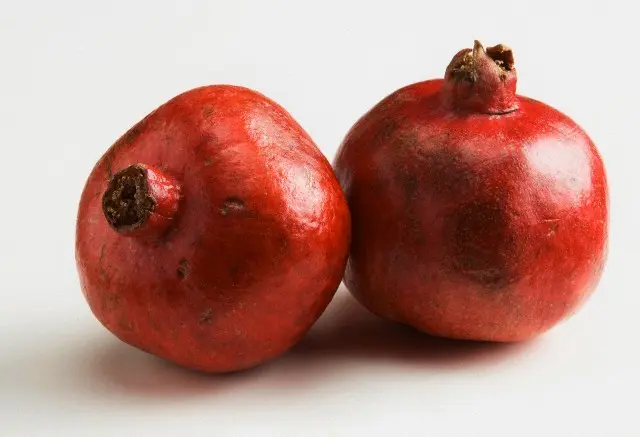
Some lovers grow indoor varieties that are compact and decorative, but the fruits, although edible, are not particularly sweet. Pomegranate loves a lot of sunlight and heat, its growing season lasts up to 8 – 9 months, and frost below -15 degrees can be fatal. Therefore, north of the subtropics, this crop is grown in heated greenhouses and requires too much attention, which is why it is not very common.
Video “Benefit”
From the video you will find out what are the benefits of this fruit.
Species and varieties
There are two main varieties of pomegranate – with hard and soft bones. There are early ripe varieties that are grown in our country, they do not differ in special requirements for conditions. But varieties with soft bones are considered more capricious, they require much more attention and trouble. Not every climate and far from every soil can suit them.
“Kizil-anor”
Pomegranates of this variety come to us from Uzbekistan. They ripen by the beginning of October – this variety is considered early. Fruits of different sizes are distinguished by a pink-scarlet skin, red grains have a sweet and sour taste.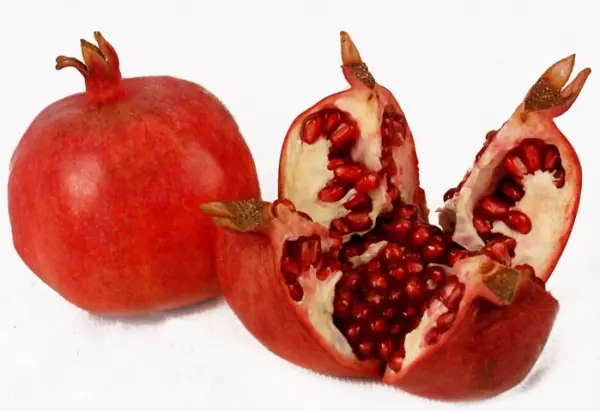
“Ak Dona Crimean”
It grows well in the steppes of the Crimea, but the bushes need to be covered for the winter. Large oval fruits are covered with a thin creamy skin with red spots. Pink-red grains are sweet with a barely noticeable sourness.
“Gyuleysha pink”
Cultivated in Azerbaijan. On bushes up to 3 meters high with straight prickly shoots, rounded or rounded elongated fruits grow with an average weight of about 250 g, but there are also more than 600 g. The fruits are covered with a thin, very light crust, creamy white, sometimes with pink stripes. The grains are small, dark cherry with a sweet and sour taste. Harvest is stored no more than four months.
“Red Guleisha”
Pomegranate varieties “Gyuleysha Krasnaya” are usually round in shape with a carmine-red peel, the stripes are well-defined at the very top. The grains are large, dark cherry, reminiscent of Rose Guleisha. Both of these varieties are considered Azerbaijani.
“Child Mursal”
Also an Azerbaijani variety, it is considered one of the best in terms of taste. Slightly flattened fruits of medium size (about 250 g) delight with a light raspberry-red blush. The grains can be red or raspberry, contain up to 16 percent of sugars, and ripen by mid-October. More than 20 kg of fruits are usually obtained from one bush.
“Cossack Improved”
It is usually cultivated as a medium-sized tree with large, rounded fruits. The skin of the fruit is greenish-cream, with strokes, stripes, spots and specks over the entire surface. A carmine-red integumentary color often appears. The peel is not thick, creamy yellow inside, and the grains are large, pink-red. The taste is very pleasant, rich, sweet with a noticeable acidity.
“Achik-Anar”
This is a small tree that produces fruits of uneven size, round, but noticeably tapering towards the base. The skin of the fruit has an unusual dark green color with a carmine cover, so the top of the fruit is completely dark carmine. The skin is thick even in a ripe pomegranate, carmine inside, large grains have a dark cherry color and a bright sweet and sour taste.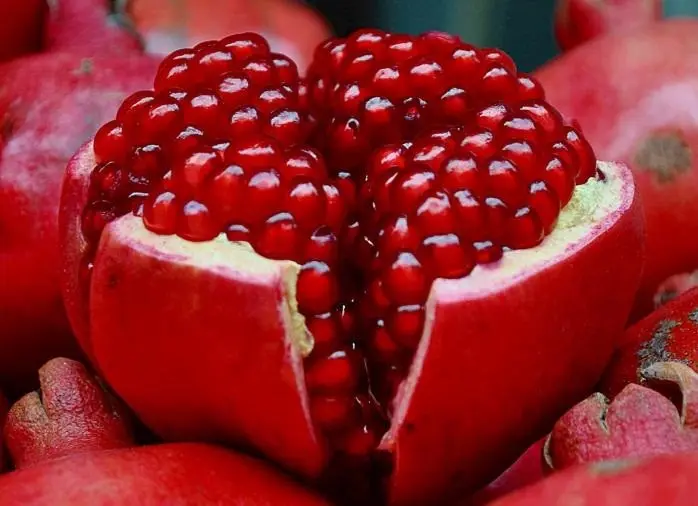
“Nikitsky Early”
It grows as a medium-sized tree with very large fruits. The skin, medium in thickness, is painted with an even carmine-red color, and the grains are very small, dark cherry. The taste of the grains seems sweeter than the sweet and sour juice from them. The fruit differs from other varieties in its high thick neck with a large calyx.
Benefit and harm
Pomegranate juice or the pulp of its berries are very useful, they contain so many substances necessary for a person that they contribute to overcoming many diseases and general strengthening of the body.
The use of these exotic fruits strengthens the immune system, improves the functioning of the heart and blood vessels, stabilizes the work of the stomach and intestines, lowers blood pressure, slows down the overall aging of the body, and is an excellent prevention of cancer.
Fruits contain potassium, iron, calcium, phosphorus, sodium, magnesium and even valuable amino acids, like those found only in meat, so pomegranates should be consumed by vegetarians. Vitamins A, C, E, groups P and B strengthen blood vessels, calm nerves, improve blood composition, rejuvenate the skin. Sugars and acids make the grains not only tasty, they are easily digested, enriching us with energy. True, acids can harm tooth enamel, so the juice (it is used diluted with water) should be drunk through a straw, and after eating the grains, you should brush your teeth or at least rinse your mouth with clean water.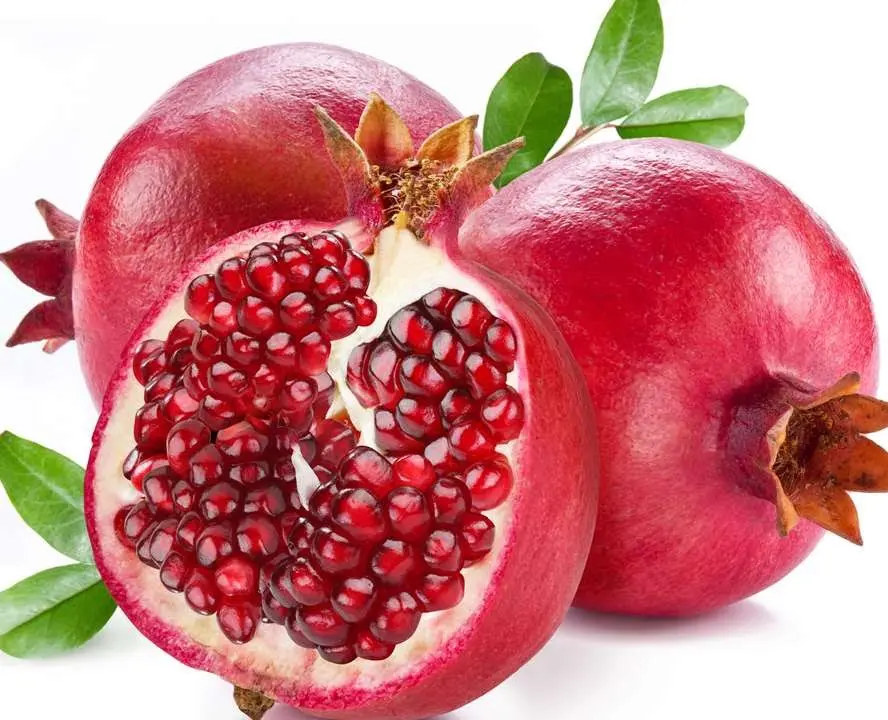
For a long time, all parts of the plant have been used for treatment, and folk medicine uses the fruit one hundred percent. Bones relieve headaches and normalize blood pressure. White partitions calm the nerves and increase stress resistance. The skin eliminates indigestion, heals burns and expels worms.
Pomegranate juice can stimulate appetite and improve digestion. And the dried skin or its decoction can get rid of pathogenic microorganisms, even cope with a dysentery bacillus. The high content of vitamins allows the pomegranate to fight cholesterol, make the walls of blood vessels clean and elastic. Organic acids and tannins make the pomegranate indispensable in the fight against colds. A decoction of the skin or diluted juice is used for rinsing with tonsillitis, laryngitis, stomatitis. A decoction of crushed bark reduces inflammation, alleviates the condition with various diseases of the vessels, kidneys, and liver. Pomegranate removes radiation and slows down aging.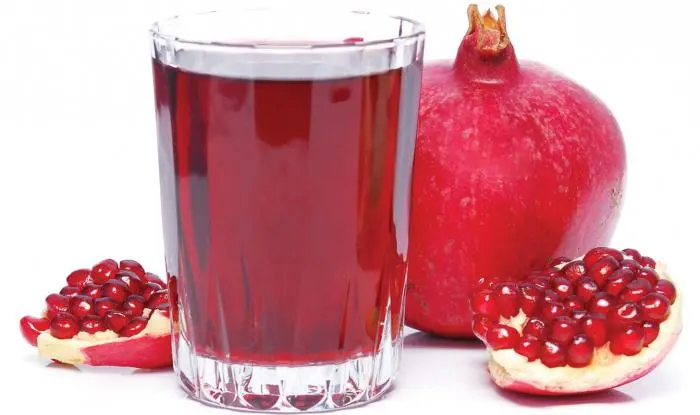
But a fruit with such an amazing activity of all its components cannot be harmless. It should be used with great caution in people who have high acidity or have peptic ulcers of the stomach and duodenum. Powders, decoctions, infusions of the skin should be taken very carefully, an overdose can lead to unpleasant consequences – dizziness, weakness, even convulsions.
Breastfeeding mothers should limit the use of pomegranate, because the child may have an allergy or simply disrupt the intestines, it is best to drink diluted juice in moderate doses.
Children from the age of 9 months begin to give juice, but it must also be diluted.
People who are prone to allergies of various kinds should not drink pomegranate juice or feast on grains uncontrollably, it is worth starting with small portions to make sure that there is no allergic reaction.
Pomegranate is a very useful exotic fruit, but its use will bring more benefits if it is regular, and not excessive, of course, in the absence of contraindications.
Video “Varieties”
From the video you will learn about the varieties of this fruit.









